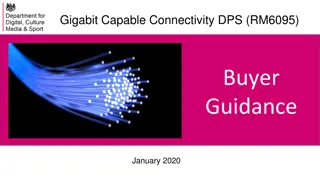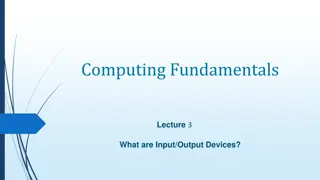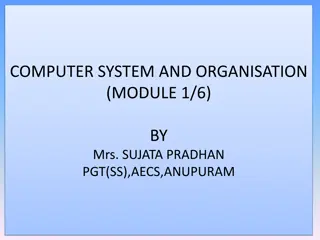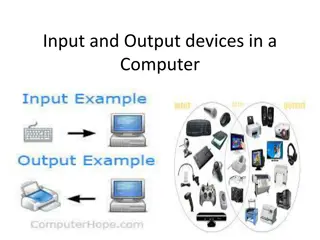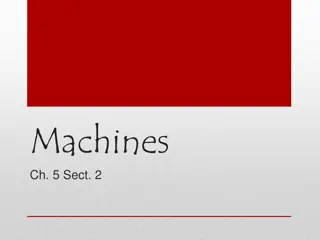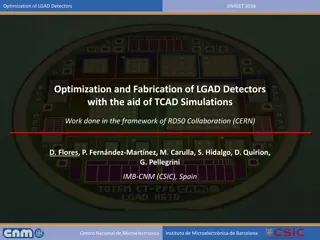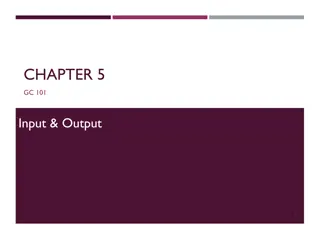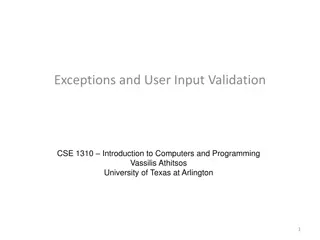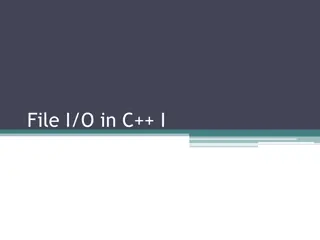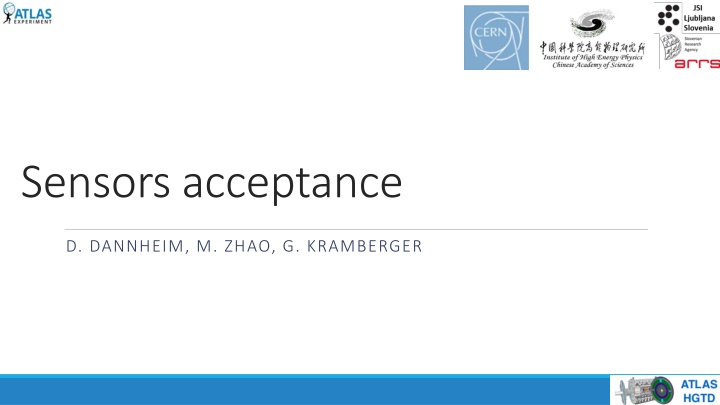
Advanced Sensor Performance Studies in Particle Detection Experiments
Explore the intricate details of sensor acceptance and performance for future implementation in event digitization. Key areas of focus include charge collection simulations, measurements with HGTD sensors, and improving the DPS for realistic experimental lifetime performance.
Download Presentation

Please find below an Image/Link to download the presentation.
The content on the website is provided AS IS for your information and personal use only. It may not be sold, licensed, or shared on other websites without obtaining consent from the author. If you encounter any issues during the download, it is possible that the publisher has removed the file from their server.
You are allowed to download the files provided on this website for personal or commercial use, subject to the condition that they are used lawfully. All files are the property of their respective owners.
The content on the website is provided AS IS for your information and personal use only. It may not be sold, licensed, or shared on other websites without obtaining consent from the author.
E N D
Presentation Transcript
Sensors acceptance D. DANNHEIM, M. ZHAO, G. KRAMBERGER
What is needed? We have gained a very good understanding of sensors performance and their properties: Simulations of charge collection and timing Measurements with HGTD sensors connected to discrete electronics The final goal is of course implementation of event digitization using the real data on damage and performance. This studies are ongoing. The first step would however be improvement of the DPS with more realistic performance over the lifetime of the experiment. Produces functions: Vop( ?, ??) CC( ?, ??) at Vbias<VSEB most probable charge ????( ?, ??, ??) taking into account the factorization of the timing resolution Module ON/OFF In order to do so we need to prepare/a preparing a function/class which reads the latest geometry (position of the modules) reads the fluence profiles of charged hadrons Include the parametrization of the measured and simulated properties: Charge collection as a function of fluence ration of acceptor removal for charged hadrons and neutrons measured time resolution broken down into components with discrete electronics (TB,Sr90) ALTIROC performance in terms of contributions to timing: jitter(CC), TDC, ToA/ToT residuals 2 D. DANNHEIM, M. ZHAO, G. KRAMBERGER, SENSORS: ACCEPTANCE, HGTD WEEK 5/2/2025
What can we miss for now? What can be missed in the first steps, but will be implemented later once full digitization is available: Influence of thermal gradient across the sensor (~0.5 ps/C at fixed bias voltage UCSC boards) and power dissipation effects on the sensor performance. limitations of the bias voltage due to gradient of fluence across the sensor (~15% maximum difference in fluence across the sensor at low radia) variations of the individual sensor/module properties (sensors with Vbd~165 V and those with Vbd~195 V have different radiation hardness) ?? ~ ? ??? ~????? ?? ??? ??? accurate evaluation of inter-pad performance (effective IP gap and its changes with fluence) Charge screening effects related also to magnetic field maps 3 D. DANNHEIM, M. ZHAO, G. KRAMBERGER, SENSORS: ACCEPTANCE, HGTD WEEK 5/2/2025
Measured parameters - CC Note charge collection is a sole property of the sensor Vop is defined according to specifications In mixed irradiation fields the neutron reference fluence needs to be rescalled eq,scaled = eq,n + ?? ?? eq,CH 4 D. DANNHEIM, M. ZHAO, G. KRAMBERGER, SENSORS: ACCEPTANCE, HGTD WEEK 5/2/2025
Landau fluctuation parametrization LF depend on both electric field and gain the higher the gain the larger the impact on the time resolution fluctuations are amplified for the gain the gradient in the electric field means variation in the drift time of the fluctuating charges ideally saturated drift velocity in the sensor at very high fields IHEP-IME preproduction @100V@-30C 1/|E| follows from velocity saturation The field in the sensors is not uniform, but average field |E|=Vbias/D is a good approximation. HPK-P2-W43 @ 165V@-30C Note that for the most of HGTD we will be to run at ~>15 fC. Lower charge will lead to less LF. GEANT4 simulation A perfect ToA/ToT or CFD correction was assumed in the measurements. 5 D. DANNHEIM, M. ZHAO, G. KRAMBERGER, SENSORS: ACCEPTANCE, HGTD WEEK 5/2/2025
ALTIROC Jitter Assumption of the Dirac pulse fast injection We will need to have at least threshold of 3 fC which requires the MPV charge of at least 5 fC in order to meet specs on efficiency and noise occupancy. Jitter is a function of the noise so we need to know also Noise(leakage current). 6 D. DANNHEIM, M. ZHAO, G. KRAMBERGER, SENSORS: ACCEPTANCE, HGTD WEEK 5/2/2025
ALTIROC TDC/Clock/ TDC/Clock/Residuals from ToA/ToT We need better statistics and knowledge about that, but: Laser measurements show combined resolution of ~25 ps If jitter is around 14 ps TDC/clock dist. leads to 20 ps ToA/ToT time walk correction? ??? ideally small charge and leakage current dependent (radiation) charge and voltage dependent (radiation) Independent on charge/leakage 7 D. DANNHEIM, M. ZHAO, G. KRAMBERGER, SENSORS: ACCEPTANCE, HGTD WEEK 5/2/2025
Simulation flow and time stamping DPS SCHEME FINAL SCHEME Track hit in ATHENA r(x,y,z), thit,MC ?? , dE/dx in steps over the depth Track hit in ATHENA r(x,y,z), thit,MC ?? , Q The class HGTDTimePerf takes the ATHENA data & Threshold of the ALTIROC and returns: time resolution achieved LGAD+ALTIROC (see parametrization of the resolution) digitization of the deposited charge simulation of response I(t)->ALTIROC->thit,sim collected charge thit,sim=thit,MC+ t,res assuming the resolution and hit efficiency required operation voltage hit detected YES/NO adding noise and taking all the components into account to smear the thit,sim What needs to be implemented: return of the leakage current and calculation of the noise Simulation of the performance Simulation of the performance 8 D. DANNHEIM, M. ZHAO, G. KRAMBERGER, SENSORS: ACCEPTANCE, HGTD WEEK 5/2/2025
3000 fb-1 :: R=49.497475 ::: ChF=2.597799e+14, nF=1.008577e+15::F=1.787916e+15 Charge::15.565421 @ Vop=463.297206 tau_LF=26.624382 : tau_j=12.402250 : tau_TDC=20.000000 : tau_TWR=0.000000 : tau_CLK=14.000000 ::: total = 38.192585 9 D. DANNHEIM, M. ZHAO, G. KRAMBERGER, SENSORS: ACCEPTANCE, HGTD WEEK 5/2/2025

